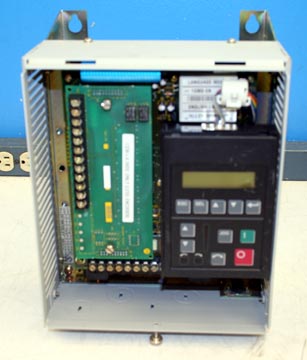
The solid-state circuitry of a variable-frequency drive can be described as having three sections:
- The first section of the drive is called the rectifier section
or converter. This section consists of a three-phase bridge rectifier.
- The second section of the drive is called the DC intermediate
section and it contains the filter components.
- The third block of the drive is called the inverter section because this is where the DC voltage is turned back into three-phase AC voltage.
This diagram shows an electronic diagram of an Allen-Bradley 1336 drive. Each section of the drive is shown with the actual components connected as you would find them when you opened the drive to troubleshoot it (see image on left). The rectifier section of this drive utilizes a three-phase bridge rectifier, which is actually a module. This means it can be removed and replaced as a unit rather quickly if it fails. In a future article we will show a picture of this type of module and explain its internal operations. The output of the rectifier section is six half-waves. A set of metal-oxide varistors' connected to the input of the rectifier section to protect against voltage surges.

above: Schematic of an AC VFD. The major components of the drive include the rectifier, the filter, and the output transistors. Click here for a full-resolution image.
When the input voltage to the drive is 480 volts ac, the output dc volts from the rectifier section will be approximately 670 volts dc. The pulsing DC voltage is applied to the DC bus on this system. The DC bus is identified by the +DC and the -DC wires that run through the length of the drive circuit.
The filter section of the drive uses capacitors and an inductor to filter the voltage and current. The capacitors have a pre-charge circuit that allows the capacitors to reach full charge slowly so that they are not damaged. The capacitors are connected in parallel with the DC bus, and the inductor is connected in series with the negative DC bus wire. A set of resistors is provided to discharge the capacitors anytime power is removed. You should always allow sufficient time for the capacitors to discharge before you try to work on the solid-state components in the drive. The filter allows the pulsing DC voltage to be changed to pure DC.
The output section of the drive converts the DC voltage back to three-phase voltage. This section uses pulse-width modulation (PWM) techniques to switches three pairs of transistors on and off up to 12 times during each half-wave to produce a three-phase output. The amplitude of the signal determines the amount of voltage for the AC voltage, and the frequency of the signal will determine the frequency of the output of the drive. In most cases the output frequency can be any value between 0-120 Hz. Some drives allow the upper frequency to reach 400 Hz.
The output transistors are connected across the DC bus. One transistor is connected to the positive DC bus wire, and when it's switched on and off, it will provide the positive half-cycle for one phase of the AC signal. The second transistor is connected to the negative DC bus wire, and when it's switched on and off, it will provide the negative half-cycle for one phase of the AC signal. The base drive board provides the PWM signals for all of the transistors. The drive contains a microprocessor that accepts the command signal and determines the correct frequency and voltage for the output transistors.